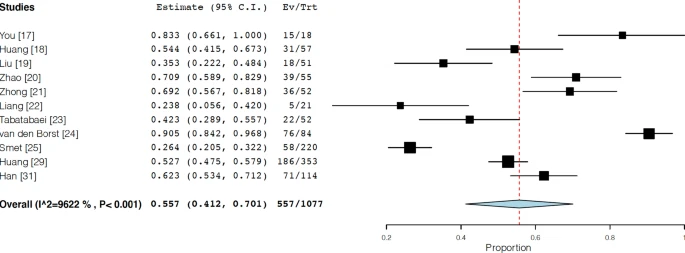The coronavirus disease 2019 (COVID-19) causes a wide spectrum of lung manifestations ranging from mild asymptomatic disease to severe respiratory failure. We aimed to clarify the characteristics of radiological and functional lung sequelae of COVID-19 patients described in follow-up period.
PubMed and EMBASE were searched on January 20th, 2021 to investigate characteristics of lung sequelae in COVID-19 patients. Chest computed tomography (CT) and pulmonary function test (PFT) data were collected and analyzed using one-group meta-analysis.
Results
Our search identified 15 eligible studies with follow-up period in a range of 1–6 months. A total of 3066 discharged patients were included in these studies. Among them, 1232 and 1359 patients were evaluated by chest CT and PFT, respectively. The approximate follow-up timing on average was 90 days after either symptom onset or hospital discharge. The frequency of residual CT abnormalities after hospital discharge was 55.7% (95% confidential interval (CI) 41.2–70.1, I2 = 96.2%). The most frequent chest CT abnormality was ground glass opacity in 44.1% (95% CI 30.5–57.8, I2 = 96.2%), followed by parenchymal band or fibrous stripe in 33.9% (95% CI 18.4–49.4, I2 = 95.0%). The frequency of abnormal pulmonary function test was 44.3% (95% CI 32.2–56.4, I2 = 82.1%), and impaired diffusion capacity was the most frequently observed finding in 34.8% (95% CI 25.8–43.8, I2 = 91.5%). Restrictive and obstructive patterns were observed in 16.4% (95% CI 8.9–23.9, I2 = 89.8%) and 7.7% (95% CI 4.2–11.2, I2 = 62.0%), respectively.
This systematic review suggested that about half of the patients with COVID-19 still had residual abnormalities on chest CT and PFT at about 3 months. Further studies with longer follow-up term are warranted.

No comments:
Post a Comment